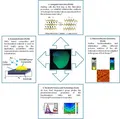| Title: | ATUMS 1-4: Optoelectronic Properties of solution-processable spray-deposited CNT Networks |
| Partners: | University of Alberta, Edmonton, Canada & Technische Universität München TUM, Internationale Graduiertenschule für Funktionelle Hybridmaterialen (ATUMS), München, Germany |
| Funding: | funding through Deutsche Forschungsgemeinschaft DFG, Bonn, DFG IRTG 2022 "ATUMS" Project 1-4 |
| Duration: | 2015- |
| Contact: | Professor Dr. Bernhard Rieger, Technische Universität München (TUM), Fakultät für Chemie WACKER-Lehrstuhl für Makromolekulare Chemie, Garching |
| Homepage: | www.makro.ch.tum.de/index.php www.dfg.de/foerderung/programme/listen/projektdetails/index.jsp |
TUM: Paolo Lugli, Thomas Fässler
UofA: Frank Hegmann, Jonathan Veinot
Doctoral Candidates: Alina Lyuleeva, Mary Naretto
Aim of the project / Overview
We will explore the eletrical, electronic and optoelectronic propoerties of solution-processable spray-deposited random CNT and Ag networks developed at the TUM Institute for Nanoelectronics by measuring their transient photoconductivity using time-resolved terahertz (THz) spectroscopy (TRTS) in the Ultrafast Spectroscopy Lab and Ultrafast Nanotools Lab at the University of Alberta.
These measurements will be coupled with morphological analyses carried out by AFM, investigations of the material workfunctions by mean of Kelvin probe techniques and electrical investigation via four-point-probe methods in order to correlate the transport properties of the film with the fabrication parameters and with the substrate characteristics.
Rigid (e.g., silicon and glass) as well as flexible (e.g. Kapton and PET) substrates will be studied for both metallic and semiconducting CNT networks.
Particularly interesting will be to look at the properties of mixed films, where the percentage of Ag and CNT is controllably varied.
Once the characterization of the individual films has been performed, hybrid structures will be realized.
These can consist of nanoparticles embedded into the film (by simply mixing the nanoparticles into the solutions) or by multilayered structures alternating or superimposing a conductive film (from a conductive polymer, oxide or nanoparticle film) with the CNT/Ag one. Such hybrid structures would be prepared in collaboration with the Veinot and Fässler groups.
They could constitute the active layer for a series of optoelectronic and sensing devices. Thus, in order to evaluate the potential performance of such devices, the electrical and optoelectronic properties have to be investigated as function of parameters such as e.g. film composition and thickness.




